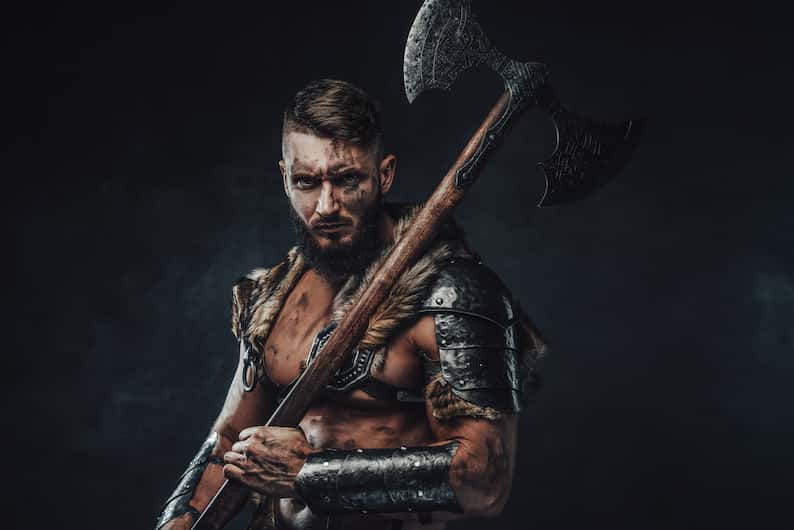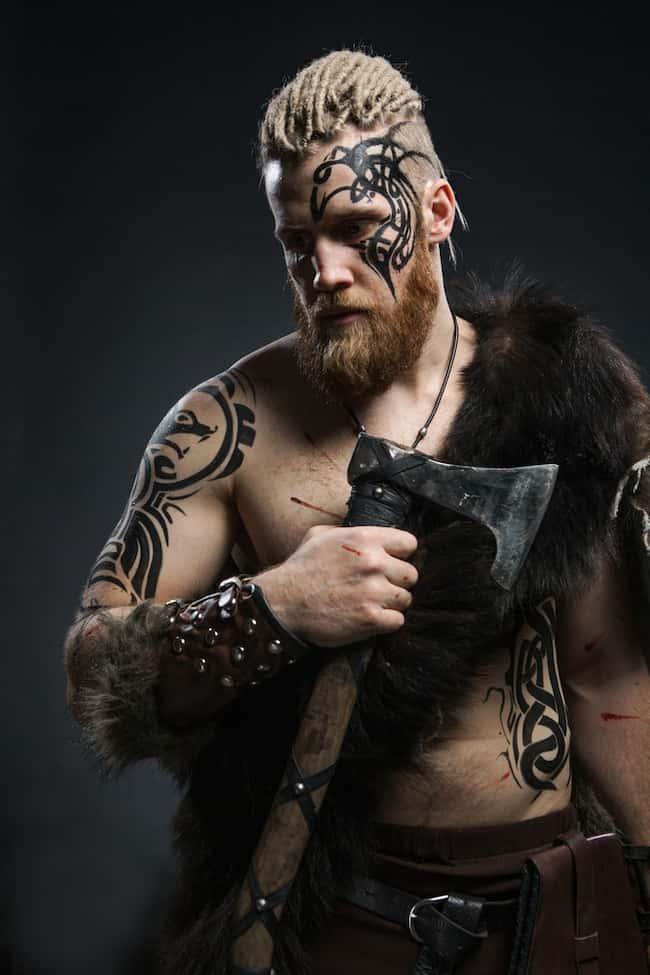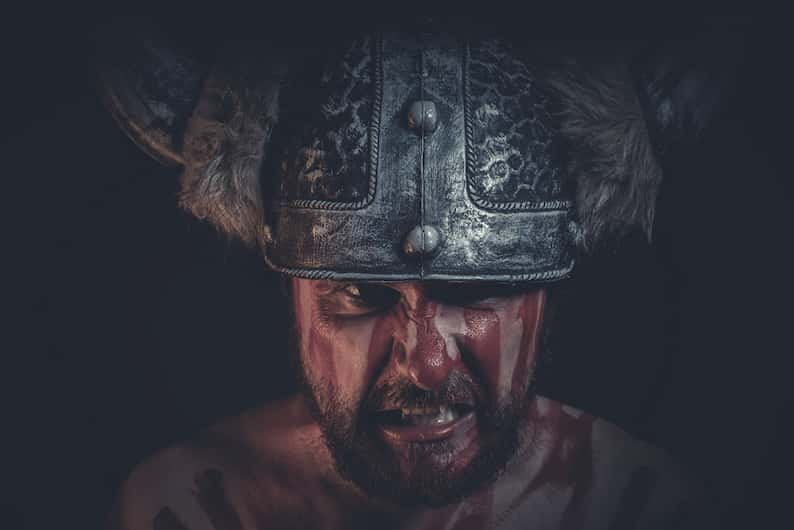It’s not a shocking statement that media representations of historical events will modify or embellish stories for theatrical impact. Enjoying a show like Vikings is perfectly fine, but you may be wondering which parts of the show’s portrayals of Viking culture are face or fiction.
In particular, if you’re wondering whether Viking face paint was really a thing that they used when descending upon the unwary in times of war, here are the answers you want.

Table of Contents
Did Vikings wear face paint?
Vikings did wear face paint for a variety of confirmed reasons, primarily cosmetic and ritualistic. In Ibn Fadlan’s account, Viking men were tattooed across nearly the entirety of their bodies, up to the neck. Face paint would give them a temporary way to extend those tattoos.
In the writings of Ibrahim ibn Ya’qub, he noted the widespread use of darkened makeup around the eyes by all Vikings, meaning that it seems clear that both female and male Vikings wore face paint in addition to his writings about the fact that Vikings had tattoos.
But given the coloring, descriptions of what Vikings looked like, and era, these references to make up most likely refer to kohl-based cosmetics. While there were still disparities between the rights and privileges, this coincides with other shared traits across the genders in Viking society.
This means that the depictions of Floki’s darkened eyes in the Vikings series are a reasonable interpretation of known Viking face painting traditions. His expanding the design to Norse runes on his forehead is a potential embellishment, but it’s not outlandish enough to call it ahistorical.
You may also be interested in: Did Vikings Have Dreadlocks?
Why did Vikings paint their eyes black?
The available writing does not detail why the early Scandinavians would use kohl to paint their eyes, but there is enough evidence from other cultures to generate a working hypothesis. That is, it’s believed to have been done for both aesthetic and antibacterial purposes.
First, and most obviously, they painted their eyes black for cosmetic enhancement. As I’ll get into a bit further below, Vikings did take care of their personal appearances. The sooty look of kohl has bolstered its appeal as a makeup for millennia, and so it’s easy to see why this also formed a key part of the Viking makeup worn at the time.
Using kohl eyeliner has also been noted as having antimicrobial effects that likely played into its adoption. While the ancient humans would have had no idea about the mechanisms of bacteria, the cause and effect of applying kohl likely encouraged its adoption into religious rituals and cosmetic habits.

Did Vikings have war paint?
Overall, there is little evidence to suggest that Vikings painted their faces specifically for military purposes on a cultural level. Conversely, there is only the absence of evidence to suggest that they didn’t. Even recent discoveries have shown that Viking groups were not as culturally and ethnically homogenous as once thought.
Given the oral history traditions of the Vikings, their cultural cares about appearance, and their belligerent military actions, it seems likely that at least some Viking groups used war paint. Some may have liberally applied more kohl than usual, smeared blood on themselves, or used other cosmetics for intimidation and individuality.
Since most face painting within the Vikings series is done with kohl, they are reasonable stretches of accepted fact. The strong blue face coloring that Astrid uses in later episodes ventures beyond that point. That said, it’s also generally accepted that Viking face paint had meanings beyond those related to war.
Was Viking face paint influenced by others?
Because of the wide range of Viking exploration and raiding, it’s reasonable to guess that the Vikings may have acquired the cultural habit from others. One nearby culture has also had the same widespread media portrayal as painted warriors: the Picts.
For connectivity between the two cultures, the same studies that shed insights into Viking genetics revealed that many Picts became part of the Viking kingdoms. This association may play into the easy crossover between the two cultures in modern minds.

The two cultures could have been in contact before the Viking Age properly began, as well. If they did have a relationship, it wasn’t one with a military alliance. The Pictish kingdom was diminishing as the Viking Era was coming into full swing, but no Viking support was noted.
With a strong potential link, it’s time to look at the Picts’ face paint to determine if their culture influenced the Vikings.
Did Picts paint their faces for war?
The Picts were given the name by others according to the reported self-painting, including their faces. This characterization may be largely attributable to an unclear meaning in the writings of Gaius Julius Caesar from his time campaigning in Britain.
They certainly used woad, a blue dye that features prominently in modern depictions such as the film King Arthur. It was a commonly available source of blue coloring that also has astringent properties. If it was used as an astringent, the early characterization as painted people could have confused its medicinal use for battle wounds as a cosmetic one.
Whether they actually painted themselves for battle, tattooed themselves in other ways, or held none of those traditions is more unclear. Although the connection between the two cultures is there, the lack of strong evidence about Pict body painting traditions makes them a questionable origin for any Viking corollaries.
You may also be interested in: Did Black Vikings Ever Exist?
How did Vikings make face paint?
The most likely source of Viking face paint is kohl, also known as kajal in South Asian regions. Minerals of a dark color were ground into a fine powder that adhered to the skin with a simple spread. The primary elements were either lead-based or antimony-based.
However, other ingredients like soot from nuts were mixed into the powder for additional effects and to extend the amount.
Whether the Vikings followed this recipe, used their own variation, or traded for existing kohl is unclear. Galena, the primary ore of lead-based kohl, was coming up from Roman mining operations in modern-day Spain well before Caesar made his way to Britain. Its general use ventures back thousands of years, so pinning down one source or formula is difficult without first-hand accounts or more discovered artifacts.

What other face paints did Vikings use?
Some Vikings may have used a preparation of henbane, a plant in the nightshade family that would later earn the name belladonna due to its use by Italians as a dangerous cosmetic. Seeds of the plant and a white lead powder similar to kohl were discovered with the remains of a seeress. If mixed together as an ocular cosmetic and ritual agent, they would activate a potent if risky mix of effects that could be seen as a mystical trance.
The belladonnas knew that belladonna drops would make their pupils dilate, enhancing their appeal when staring into a suitor’s eyes. The seeress may have been using it for similar purposes, but it is just as likely that it was incorporated into other rituals or purposes. Some scholars have suggested Hensbane as the source of the notorious berserker rage of Viking warriors, so why she possessed it remains unclear. Either way, it shows that Viking face paint for females was definitely a thing.
In particular rituals, Vikings were also known to cover themselves from head to toe in blood.
Why did Vikings put blood on their faces?
Like many early religious traditions, Vikings included blood as a ritual sacrifice ingredient. These Blóts involved sprays of blood from animals and using the blood as paint across the body – including the face. The sacrificed animals were cooked while the ritual partakers shared in the bounty and pledged to undertake great adventures.
These blót rituals took place throughout the major seasonal moments throughout the year and when dire events were occurring. Since an upcoming battle might be an event worthy of a blót, it is possible that some Vikings may have had blood on their faces before their battles began.

How much do we know about Viking cosmetic traditions?
Many of the answers in this article will have large caveats. The Viking Age began just before the 800s, marked by the raid on the church at Lindisfarne in 793, and their own history was a mix of oral stories and poetry with little written or preserved. Some stories survived through these oral traditions, eventually becoming written down after many potential changes to the stories.
Archaeological finds support accepted facts like the Vikings’ tendency to groom their hair and bodies (including the possibility that Vikings had braided hair). With the number of discovered combs, historians can piece together the past just based on their composition and spread.
While the nearby residents of the British Isles did have monks practicing written history, the Vikings targeted these monasteries for raids due to their seclusion and value. Christian accounts therefore focus on the barbarous nature of the Vikings, even after the Vikings adopted Christianity. Like the oral traditions, many of the early stories were not written down until later.
That leaves scholars looking to other sources of contemporary accounts for Viking culture.
And in terms of other Viking traditions…why not learn about Viking Chess: The Ultimate Guide to Hnefatafl
What are the best written sources of Viking face painting history?
The best early written history of the Vikings comes from Islamic scholars, traders, and explorers. At the time, Spain was a part of the Islamic world, so Norse raiders and traders sailing along the coast had a ready point of contact. Despite an early Viking raid targeting the settlement of Seville in Spain, the Norsemen developed trading relationships with these far-off groups.
This allowed more insightful looks into Viking culture than the Christian monks, who understandably viewed the Vikings through the lens of their hostility. The two cultures also shared trading points due to the Vikings’ wide venturing range into Eastern Europe down rivers from the Baltic towards the Black and Caspian Seas. Volga Bulgaria was one such meeting point, the location eventually becoming the modern day republic of Tatarstan within the Russian federation.
Aḥmad ibn Faḍlān ibn al-Abbās ibn Rāšid ibn Ḥammād, frequently shortened to Ahmad ibn Fadlan, spent much time traveling with and writing about a group of Vikings and various Slavic persons who may have joined or been enslaved to the party. His writings were actually a key inspiration for Michael Crichton’s Eaters of the Dead plus its movie adaptation, The 13th Warrior.
